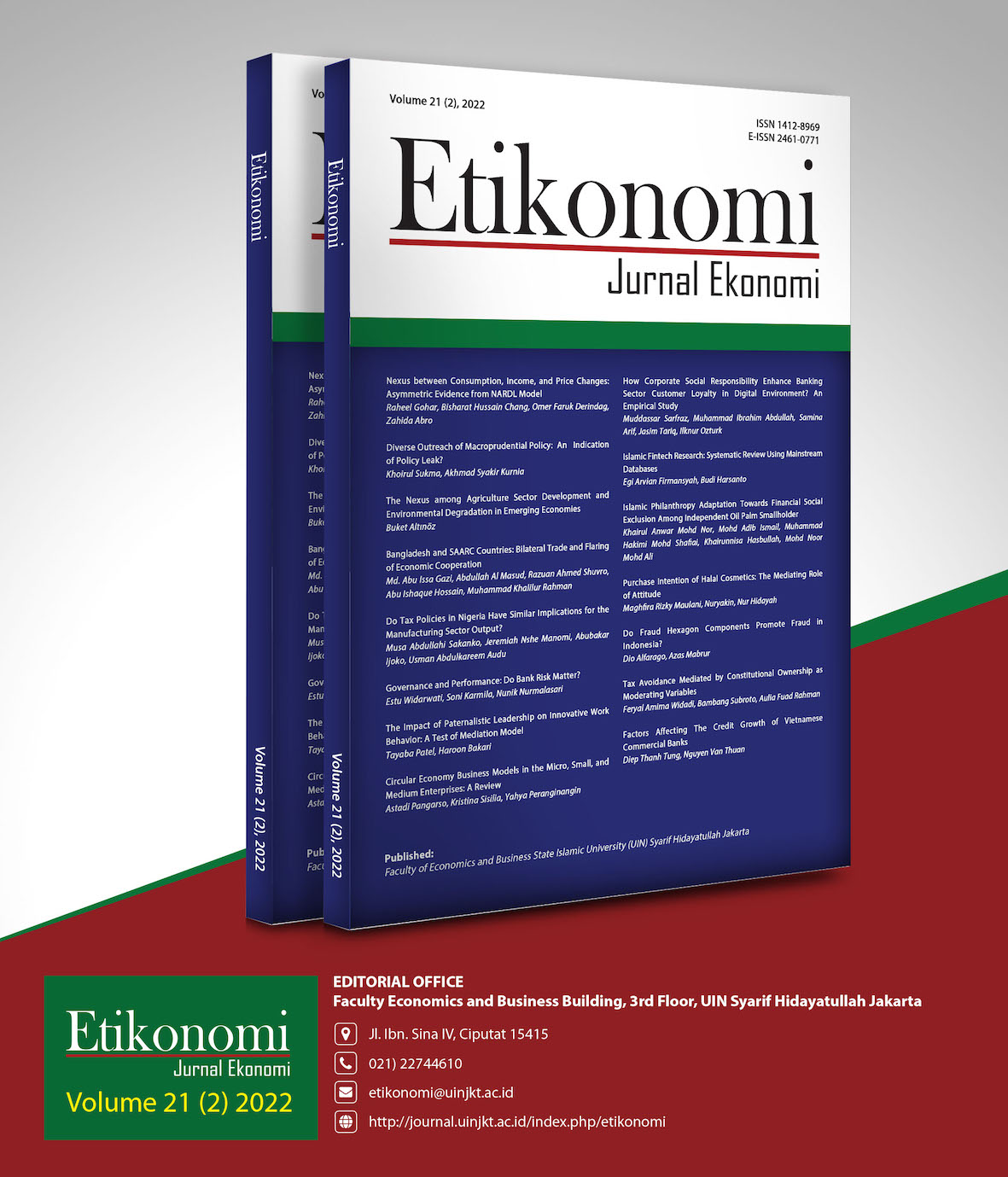Diverse Outreach of Macroprudential Policy Effect on Household and Non-Financial Corporate Loan: An Indication of Macroprudential Policy Leak?
DOI:
https://doi.org/10.15408/etk.v21i2.24304Keywords:
macroprudential policies, policy leaks, household credit growth, non-financial corporate creditAbstract
Despite increasing awareness of the importance of countercyclical policies to overcome financial system instability, the potential leak of such policies comes to attention due to economic agents' risk-taking behavior. This paper aims to investigate the potential leaks of the policy. Using the Estimator General Method of Moments-difference (GMM-diff), we found evidence that macroprudential policies are less functional in controlling non-financial firms' credit growth than household credit growth. The result amplifies hesitation about the effectiveness of macroprudential policy caused by potential leaks coming from non-financial firms' risk-taking behavior. We also found that macroprudential policy in developing countries is less effective than in developed countries. Hence, the financial stability goal cannot rely solely on macroprudential policy. Instead, it needs support from other mutual policies, such as the capital control policy and transparent regulatory boundaries, to prevent partial risk shift from regulated financial institutions to unregulated, prevalent in the less developed financial system.
JEL Classification: E42, E44, E52, E58
Downloads
References
Abiad, A., Ariccia, G. D., & Li, B. (2011). Creditless Recoveries. IMF Working Paper No. 58.
Ahnert, T., Forbes, K., Friedrich, C., & Reinhardt, D. (2021). Macroprudential FX Regulations: Shifting the Snowbanks of FX Vulnerability? Journal of Financial Economics, 140(1), 145–174. https://doi.org/10.1016/j.jfineco.2020.10.005.
Akinci, O., & Olmstead-Rumsey, J. (2018). How Effective are Macroprudential Policies? An Empirical Investigation. Journal of Financial Intermediation, 33, 33-57. https://doi.org/10.1016/j.jfi.2017.04.001.
Alam, Z., Alter, A., Eiseman, J., Gelos, G., Kang, H., Narita, M., Nier, E., & Wang, N. (2019). Digging Deeper — Evidence on the Effects of Macroprudential Policies from a New Database. IMF Working Paper No. 19/66.
Baltagi, B. H. (2005). Econometric Analysis of Panel Data (3rd ed.). John Wiley & Sons, Ltd. New Jersey.
Bank for International Settlements. (2010). Macroprudential Instruments and Frameworks: a Stocktaking of Issues and Experiences. Committee on the Global Financial System CGFS Papers No. 38.
Bank Indonesia. (2016). Mengupas Kebijakan Makroprudensial. Bank Indonesia. Jakarta.
Baum, C. F., Schaffer, M. E., & Stillman, S. (2003). Software Updates: Instrumental Variables and GMM: Estimation and Testing. Stata Journal, 3(1), 1-31.
Bhargava, A., Górnicka, L., & Xie, P. (2018). Leakages from Macroprudential Regulations: The Case of Household-Specific Tools and Corporate Credit. IMF Working Paper No. 754.
Cerutti, E., Claessens, S., & Laeven, L. (2015). The Use and Effectiveness of Macroprudential Policies : New Evidence. IMF Working Paper No. 15/61.
Constancio, V. (2012). Contagion and the European Debt Crisis. Financial Stability Review, 16, 109–121. Retrieved from: https://publications.banque-france.fr/sites/default/ files/medias/documents/financial-stability-review-16_2012-04.pdf.
De Schryder, S., & Opitz, F. (2021). Macroprudential Policy and Its Impact on the Credit Cycle. Journal of Financial Stability, 53, 100818. https://doi.org/10.1016/j.jfs.2020.100818.
Dumičić, M. (2018). Effectiveness of Macroprudential Policies in Central and Eastern European Countries. Public Sector Economic, 42(1), 1–19. https://doi.org/10.3326/pse.42.1.1.
Fendoglu, S. (2017). Credit Cycles and Capital Flows: Effectiveness of the Macroprudential Policy Framework in Emerging Market Economies. Journal of Banking & Finance, 79, 110-128. https://doi.org/10.1016/j.jbankfin.2017.03.008.
Gebauer, S., & Mazelis, F. (2019). Macroprudential Regulation and Leakage to the Shadow Banking Sector. DIW Berlin Discussion Paper No. 1814.
Hodula, M., & Ngo, N. A. (2021). Does Macroprudential Policy Leak ? Evidence from Non-Bank Credit Intermediation in EU Countries. Czech National Bank Working Paper No. 5/2021.
International Monetary Fund. (2009). Guidance to Assess the Systemic Importance of Financial Institutions, Markets, and Instruments : Initial Considerations Report to the G-20 Finance Ministers and Central Bank Governors. Retrieved from: https://www.imf.org/external/np/g20/pdf/100109.pdf.
International Monetary Fund. (2013). The Interaction of Monetary and Macroprudential Policies. IMF Policy Papers, 1–25.
Lee, M., Asuncion, R. C., & Kim, J. (2016). Effectiveness of Macroprudential Policies in Developing Asia: An Empirical Analysis. ADB Economics Working Paper Series No. 157507-2.
Roodman, D. (2009). How to Do Xtabond2: An Introduction to Difference and System GMM in Stata. Stata Journal: Promoting Communications on Statistics and Stata, 9(1), 86–136. https://doi.org/10.1177/1536867x0900900106.
Smaga, P. (2014). The Concept of Systemic Risk. Systemic Risk Centre's Special Paper Series, 5, 1–26. https://papers.ssrn.com/sol3/papers.cfm?abstract_id=2477928.
Takáts, E., & Upper, C. (2013). Credit and Growth After Financial Crises. BIS Working Paper No. 416/
Utari, G. A. D., Arimurti, T., & Kurniati, I. N. (2012). Prosiklikalitas Sektor Perbankan dan Faktor-Faktor yang Mempengaruhi. Jurnal BPPK, 5, 1–14.
Vinals, J. (2011). Macroprudential Policy: an Organizing Framework. IMF Policy Paper Vol. 2011(18). https:doi.org/10.5089/9781498339179.007.
Warjiyo, P., & Juhro, S. M. (2016). Kebijakan Bank Sentral: Teori dan Praktik. Rajagrafindo Persada. Jakarta
Zhang, L., & Zoli, E. (2016). Leaning Against the Wind : Macroprudential Policy in Asia. Journal of Asian Economics, 42, 33–52. https://doi.org/10.1016/j.asieco.2015.11.001.










